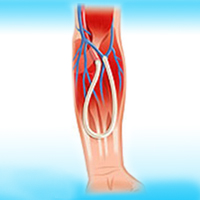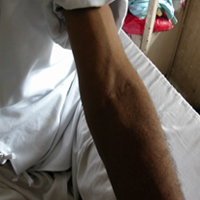It is a surgically created short circuit between an artery (a high pressure blood vessel) and a vein (a low pressure blood vessel).
Your nephrologist has advised that you will require a dialysis. This means that you will require your blood cleansed by an artificial kidney machine at least three times a week for a prolonged period till your kidney recovers its original function or you receive a transplant. Puncturing your veins so frequently to withdraw blood and send it back to you after cleansing will cause clots to form in them and very soon you will have no open veins to use for dialysis. So creating a fistula will make you veins fatter & thicker so as to sustain repeated puncturing for dialysis. Your vein also becomes more easily visible, thus making it easier to stick a needle into it.
Ideally, it is planned at least 8 weeks prior to dialysis so as to allow the vein to mature (thicken) after creation. However very often it needs to be used earlier as the patient is diagnosed late with kidney failure and so needs to be dialyzed earlier. A neck catheter can then be used temporarily for dialysis till your fistula is ready for use.
The neck catheter serves only for about 4 weeks till the fistula is ready for use. Beyond this it is likely to get infected and also block the large veins in your chest and cause your arm to swell.
The wrist of your non dominant (left for a right handed person) hand is ideal. However the veins here might not be found suitable due to poor size or previous punctures. So other sites such as the opposite wrist, front of elbow and even the thigh may be used. Some times when your own veins are not good enough, synthetic blood vessels may have to be used. Only a vascular surgeon is best equipped to decide which site and what fistula is best suited for you. An ultrasound of your blood vessels (mapping) helps planning for your fistula.
Being an artificially created short circuit, the body always has a tendency to close the fistula. However 1 yr patency rates are around 75%-80% for fistulas made of your own blood vessels (native fistula) and 35%-40% when artificial blood vessels are used. There are however way and means to open out and keep open these fistulas which you should discuss with your vascular surgeon.
Wrist fistulas can be made under local anesthesia. Other fistulas require some form of higher anesthesia such as a brachial block (numbing your entire arm for a while by injections near your neck) or a general anesthesia.
Almost always, these surgeries can be done as a day-case. Sometimes you might require an overnight admission.




